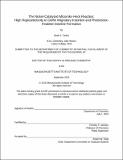The nickel-catalyzed Mizoroki-Heck reaction : high regioselectivity in Olefin migratory insertion and photoredox-enabled indoline formation
Author(s)
Tasker, Sarah Z. (Sarah Zinnen)
DownloadFull printable version (9.371Mb)
Other Contributors
Massachusetts Institute of Technology. Department of Chemistry.
Terms of use
Metadata
Show full item recordAbstract
[chemical formula and color illustrations ...] Achieving high selectivity in the Heck reaction of electronically unbiased alkenes has been a longstanding challenge. Using a nickel-catalyzed cationic Heck reaction, we were able to achieve excellent selectivity for branched products (>/=19:1 in all cases) over a wide range of aryl electrophiles and aliphatic olefins. A bidentate ligand with a suitable bite angle and steric profile was key to obtaining high branched/linear selectivity, while the appropriate base suppressed alkene isomerization of the product. Though aryl triflates are traditionally used to access the cationic Heck pathway, we have shown that by using triethylsilyl trifluoromethanesulfonate we can effect a counterion exchange of the catalytic nickel complex such that cheaper and more stable aryl chlorides, mesylates, tosylates, and sulfamates can be used to yield the same branched products with high selectivity. [chemical formula and color illustrations ...] Nickel/photoredox catalysis is used to synthesize indolines in one step from iodoacetanilides and alkenes. Very high regioselectivity for 3-substituted indoline products is obtained for both aliphatic and styrenyl olefins. Mechanistic investigations indicate that oxidation to Ni(III) is necessary to perform the difficult C-N bond-forming reductive elimination, producing a Ni(I) complex which in turn is reduced to Ni(0). This process serves to further demonstrate the utility of photoredox catalysts as controlled single electron transfer agents in multi-oxidation state nickel catalysis.
Description
Thesis: Ph. D. in Organic Chemistry, Massachusetts Institute of Technology, Department of Chemistry, 2015. This electronic version was submitted by the student author. The certified thesis is available in the Institute Archives and Special Collections. Cataloged from student-submitted PDF version of thesis. Vita Includes bibliographical references.
Date issued
2015Department
Massachusetts Institute of Technology. Department of ChemistryPublisher
Massachusetts Institute of Technology
Keywords
Chemistry.